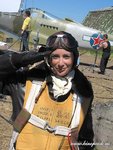In the new film "Transit," Soviet and American pilots have some close encounters at a remote Chukotka airbase during World War II.
Alexander Rogozhkin latest film "Transit", better rendered in its Russian original, "Peregon" -- refers to the World War II Lend-Lease project that sent airplanes from the United States to the Soviet Union, via Alaska and the Pacific, for onward dispatch to the front with Nazi Germany. With action starting in 1943, the film is set in the distant region of Chukotka, on a small airport that is being pushed to its limits as it regularly takes on new planes and moves them westward.
There's plenty of comedy and eventually drama in the hesitant interactions between a distinctly young group of Soviet junior officer pilots (cast from various regional acting schools, and certainly matching images of the period) and the incoming American fliers -- all of whom are equally young, but female. The casting of the latter, and their general appearance, also looks well-researched and convincing, which makes it remarkable that most of the female players were apparently drawn from a St. Petersburg bar that's a gathering place for that city's expatriates. Yet their looks, costumes and a certain naivete that's characteristic of the period certainly come across well. Tentative interaction between the two groups happens on a fairly impromptu basis, to the background of jazz and foxtrot, and across a clearly felt language barrier.
Alexander Rogozhkin latest film "Transit", better rendered in its Russian original, "Peregon" -- refers to the World War II Lend-Lease project that sent airplanes from the United States to the Soviet Union, via Alaska and the Pacific, for onward dispatch to the front with Nazi Germany. With action starting in 1943, the film is set in the distant region of Chukotka, on a small airport that is being pushed to its limits as it regularly takes on new planes and moves them westward.
There's plenty of comedy and eventually drama in the hesitant interactions between a distinctly young group of Soviet junior officer pilots (cast from various regional acting schools, and certainly matching images of the period) and the incoming American fliers -- all of whom are equally young, but female. The casting of the latter, and their general appearance, also looks well-researched and convincing, which makes it remarkable that most of the female players were apparently drawn from a St. Petersburg bar that's a gathering place for that city's expatriates. Yet their looks, costumes and a certain naivete that's characteristic of the period certainly come across well. Tentative interaction between the two groups happens on a fairly impromptu basis, to the background of jazz and foxtrot, and across a clearly felt language barrier.








